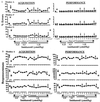Imidazenil prevention of alprazolam-induced acquisition deficit in patas monkeys is devoid of tolerance
- PMID: 10696114
- PMCID: PMC15798
- DOI: 10.1073/pnas.97.5.2314
Imidazenil prevention of alprazolam-induced acquisition deficit in patas monkeys is devoid of tolerance
Abstract
The partial allosteric modulators (PAMs) of gamma-aminobutyric acid-gated Cl(-) current intensities at gamma-aminobutyric acid type A receptors have high affinity but low intrinsic efficacy on benzodiazepine recognition sites. Unlike the full allosteric modulators (FAM), like alprazolam, triazolam, and diazepam, PAMs are virtually devoid of unwanted side effects, including tolerance. Imidazenil (IMD) is a PAM that elicits potent anxiolytic and anticonvulsant actions in rodents and nonhuman primates and retains its anticonvulsant and anxiolytic effects, even in rodents that are tolerant to FAMs. IMD antagonizes the side effects of FAMs in rodents and nonhuman primates. Using patas monkeys and a multiple schedule with repeated acquisition and performance of chain responses, we report that IMD administration for 17 days antagonized without showing tolerance ALP-induced disruption of acquisition.
Figures




Similar articles
-
Imidazenil, a new anxiolytic and anticonvulsant drug, attenuates a benzodiazepine-induced cognition deficit in monkeys.J Pharmacol Exp Ther. 1995 Jun;273(3):1307-12. J Pharmacol Exp Ther. 1995. PMID: 7791102
-
Imidazenil: a new partial positive allosteric modulator of gamma-aminobutyric acid (GABA) action at GABAA receptors.J Pharmacol Exp Ther. 1993 Aug;266(2):1018-28. J Pharmacol Exp Ther. 1993. PMID: 8394902
-
Anticonvulsant, anxiolytic, and non-sedating actions of imidazenil and other imidazo-benzodiazepine carboxamide derivatives.Pharmacol Biochem Behav. 2010 Jun;95(4):383-9. doi: 10.1016/j.pbb.2010.02.016. Epub 2010 Mar 19. Pharmacol Biochem Behav. 2010. PMID: 20227434
-
Benzodiazepines on trial: a research strategy for their rehabilitation.Trends Pharmacol Sci. 1996 May;17(5):192-200. doi: 10.1016/0165-6147(96)10015-8. Trends Pharmacol Sci. 1996. PMID: 8669126 Review.
-
From GABAA receptor diversity emerges a unified vision of GABAergic inhibition.Annu Rev Pharmacol Toxicol. 1998;38:321-50. doi: 10.1146/annurev.pharmtox.38.1.321. Annu Rev Pharmacol Toxicol. 1998. PMID: 9597158 Review.
Cited by
-
The combination of huperzine A and imidazenil is an effective strategy to prevent diisopropyl fluorophosphate toxicity in mice.Proc Natl Acad Sci U S A. 2008 Sep 16;105(37):14169-74. doi: 10.1073/pnas.0807172105. Epub 2008 Sep 10. Proc Natl Acad Sci U S A. 2008. PMID: 18784370 Free PMC article.
-
Valium without dependence? Individual GABAA receptor subtype contribution toward benzodiazepine addiction, tolerance, and therapeutic effects.Neuropsychiatr Dis Treat. 2018 May 23;14:1351-1361. doi: 10.2147/NDT.S164307. eCollection 2018. Neuropsychiatr Dis Treat. 2018. PMID: 29872302 Free PMC article. Review.
-
A neurochemical basis for an epigenetic vision of psychiatric disorders (1994-2009).Pharmacol Res. 2011 Oct;64(4):344-9. doi: 10.1016/j.phrs.2011.05.026. Epub 2011 Jun 15. Pharmacol Res. 2011. PMID: 21699980 Free PMC article. Review.
-
GABAergic dysfunction in schizophrenia: new treatment strategies on the horizon.Psychopharmacology (Berl). 2005 Jul;180(2):191-205. doi: 10.1007/s00213-005-2212-8. Epub 2005 Apr 28. Psychopharmacology (Berl). 2005. PMID: 15864560 Review.
-
Imidazenil: a low efficacy agonist at alpha1- but high efficacy at alpha5-GABAA receptors fail to show anticonvulsant cross tolerance to diazepam or zolpidem.Neuropharmacology. 2008 Aug;55(2):148-53. doi: 10.1016/j.neuropharm.2008.05.002. Epub 2008 May 9. Neuropharmacology. 2008. PMID: 18555494 Free PMC article.
References
-
- Costa E, Guidotti A. Trends Pharmacol Sci. 1996;17:192–200. - PubMed
-
- Costa E. Annu Rev Pharmacol Toxicol. 1998;38:321–350. - PubMed
-
- Woods J H, Katz J L, Winger G. Pharmacol Rev. 1992;44:155–347. - PubMed
-
- Rudolph U, Crestani F, Benke D, Brunig I, Benson J A, Fritschy J-M, Martin J R, Bluethmann H, Mohler H. Nature (London) 1999;401:796–800. - PubMed
-
- Akbarian S, Kim J J, Potkin S G, Hagman J O, Tafazzoli A, Bunney W E, Jr, Jones E G. Arch Gen Psychiatry. 1995;52:258–266. - PubMed
Publication types
MeSH terms
Substances
Grants and funding
LinkOut - more resources
Full Text Sources
Miscellaneous

